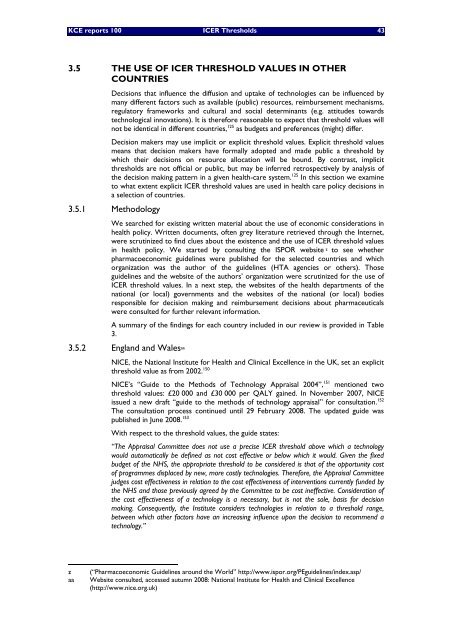Valeurs seuils pour le rapport coût-efficacité en soins de santé - KCE
Valeurs seuils pour le rapport coût-efficacité en soins de santé - KCE
Valeurs seuils pour le rapport coût-efficacité en soins de santé - KCE
Create successful ePaper yourself
Turn your PDF publications into a flip-book with our unique Google optimized e-Paper software.
<strong>KCE</strong> reports 100 ICER Thresholds 43<br />
3.5 THE USE OF ICER THRESHOLD VALUES IN OTHER<br />
COUNTRIES<br />
Decisions that influ<strong>en</strong>ce the diffusion and uptake of technologies can be influ<strong>en</strong>ced by<br />
many differ<strong>en</strong>t factors such as availab<strong>le</strong> (public) resources, reimbursem<strong>en</strong>t mechanisms,<br />
regulatory frameworks and cultural and social <strong>de</strong>terminants (e.g. attitu<strong>de</strong>s towards<br />
technological innovations). It is therefore reasonab<strong>le</strong> to expect that threshold values will<br />
not be id<strong>en</strong>tical in differ<strong>en</strong>t countries, 125 as budgets and prefer<strong>en</strong>ces (might) differ.<br />
Decision makers may use implicit or explicit threshold values. Explicit threshold values<br />
means that <strong>de</strong>cision makers have formally adopted and ma<strong>de</strong> public a threshold by<br />
which their <strong>de</strong>cisions on resource allocation will be bound. By contrast, implicit<br />
thresholds are not official or public, but may be inferred retrospectively by analysis of<br />
the <strong>de</strong>cision making pattern in a giv<strong>en</strong> health-care system. 125 In this section we examine<br />
to what ext<strong>en</strong>t explicit ICER threshold values are used in health care policy <strong>de</strong>cisions in<br />
a se<strong>le</strong>ction of countries.<br />
3.5.1 Methodology<br />
We searched for existing writt<strong>en</strong> material about the use of economic consi<strong>de</strong>rations in<br />
health policy. Writt<strong>en</strong> docum<strong>en</strong>ts, oft<strong>en</strong> grey literature retrieved through the Internet,<br />
were scrutinized to find clues about the exist<strong>en</strong>ce and the use of ICER threshold values<br />
in health policy. We started by consulting the ISPOR website z to see whether<br />
pharmacoeconomic gui<strong>de</strong>lines were published for the se<strong>le</strong>cted countries and which<br />
organization was the author of the gui<strong>de</strong>lines (HTA ag<strong>en</strong>cies or others). Those<br />
gui<strong>de</strong>lines and the website of the authors’ organization were scrutinized for the use of<br />
ICER threshold values. In a next step, the websites of the health <strong>de</strong>partm<strong>en</strong>ts of the<br />
national (or local) governm<strong>en</strong>ts and the websites of the national (or local) bodies<br />
responsib<strong>le</strong> for <strong>de</strong>cision making and reimbursem<strong>en</strong>t <strong>de</strong>cisions about pharmaceuticals<br />
were consulted for further re<strong>le</strong>vant information.<br />
A summary of the findings for each country inclu<strong>de</strong>d in our review is provi<strong>de</strong>d in Tab<strong>le</strong><br />
3.<br />
3.5.2 England and Wa<strong>le</strong>s aa<br />
NICE, the National Institute for Health and Clinical Excel<strong>le</strong>nce in the UK, set an explicit<br />
threshold value as from 2002. 150<br />
NICE’s “Gui<strong>de</strong> to the Methods of Technology Appraisal 2004”, 151 m<strong>en</strong>tioned two<br />
threshold values: £20 000 and £30 000 per QALY gained. In November 2007, NICE<br />
issued a new draft “gui<strong>de</strong> to the methods of technology appraisal” for consultation. 152<br />
The consultation process continued until 29 February 2008. The updated gui<strong>de</strong> was<br />
published in June 2008. 153<br />
With respect to the threshold values, the gui<strong>de</strong> states:<br />
“The Appraisal Committee does not use a precise ICER threshold above which a technology<br />
would automatically be <strong>de</strong>fined as not cost effective or below which it would. Giv<strong>en</strong> the fixed<br />
budget of the NHS, the appropriate threshold to be consi<strong>de</strong>red is that of the opportunity cost<br />
of programmes displaced by new, more costly technologies. Therefore, the Appraisal Committee<br />
judges cost effectiv<strong>en</strong>ess in relation to the cost effectiv<strong>en</strong>ess of interv<strong>en</strong>tions curr<strong>en</strong>tly fun<strong>de</strong>d by<br />
the NHS and those previously agreed by the Committee to be cost ineffective. Consi<strong>de</strong>ration of<br />
the cost effectiv<strong>en</strong>ess of a technology is a necessary, but is not the so<strong>le</strong>, basis for <strong>de</strong>cision<br />
making. Consequ<strong>en</strong>tly, the Institute consi<strong>de</strong>rs technologies in relation to a threshold range,<br />
betwe<strong>en</strong> which other factors have an increasing influ<strong>en</strong>ce upon the <strong>de</strong>cision to recomm<strong>en</strong>d a<br />
technology.”<br />
z (“Pharmacoeconomic Gui<strong>de</strong>lines around the World” http://www.ispor.org/PEgui<strong>de</strong>lines/in<strong>de</strong>x.asp/<br />
aa Website consulted, accessed autumn 2008: National Institute for Health and Clinical Excel<strong>le</strong>nce<br />
(http://www.nice.org.uk)

















